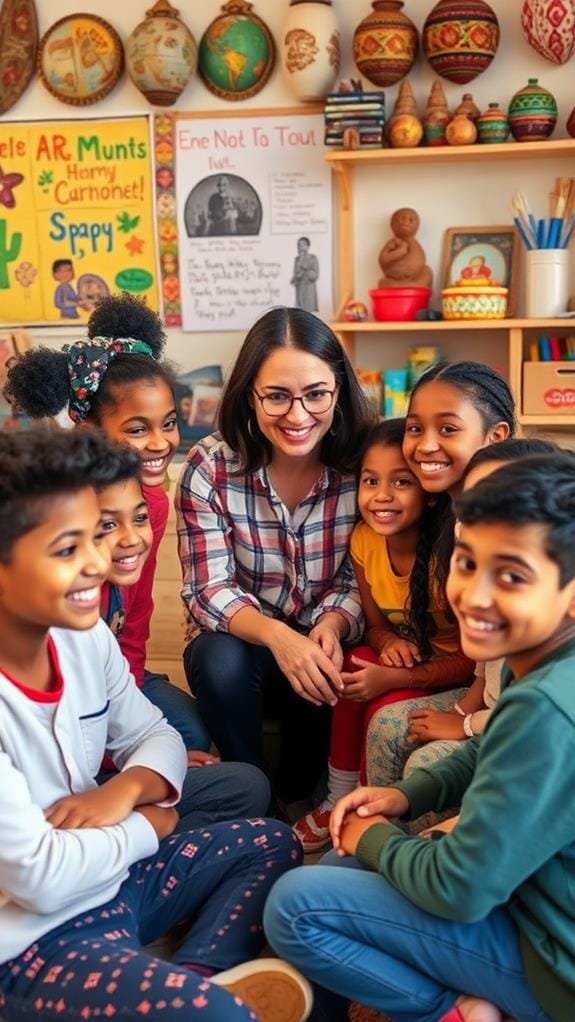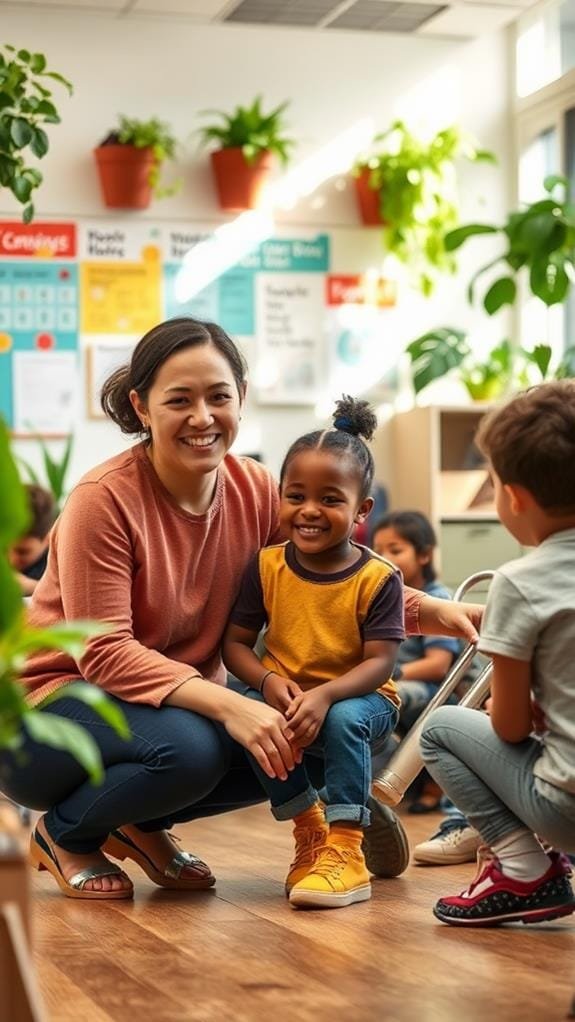To build a strong interpersonal relationship with your students, start by understanding their backgrounds—this shows you care. Create open communication channels through check-ins and anonymous feedback; when students feel heard, trust grows. Show empathy by actively listening to their feelings and offering support, making you approachable. Foster a positive classroom environment where respect is mutual and accomplishments are celebrated. Engage students with collaborative learning opportunities, allowing them to share their skills. Together, these strategies create a safe and enriching space that enhances relationships. To discover more impactful techniques, just keep exploring the ideas that follow!
Key Takeaway
- Foster open communication through routine check-ins and anonymous feedback to encourage student expression and build trust.
- Show empathy by actively listening to students’ feelings, validating their emotions, and creating a safe environment for discussions.
- Build mutual respect by valuing student opinions, demonstrating reliability, and consistently addressing conflicts promptly.
- Encourage engagement through interactive lessons and collaborative projects, making learning relevant to students’ interests and experiences.
- Establish clear boundaries and consistent expectations to create a safe and respectful classroom environment.
Understand Student Backgrounds

To build strong teacher-student relationships, it’s essential to understand your students’ backgrounds. Every student comes with a rich tapestry of experiences, cultures, and values that shape who they are. By embracing cultural awareness, you open doors to deeper connections. When students feel seen and heard, they’re more likely to trust you and engage authentically in the classroom.
One effective way to cultivate this understanding is through appreciation activities. You can organize events where students share their traditions, stories, or even food from their cultures. This not only enriches the classroom experience but also allows you to showcase the beauty of diversity. Plus, it can create a sense of belonging—a key factor in fostering a secure environment for learning.
Take time to learn about the neighborhoods where your students live. Understanding their environments gives you a clearer picture of the challenges they face and the strengths they bring. Maybe someone faces language barriers or struggles with family dynamics; knowing this can help you tailor your approach to support them better.
Encourage students to express themselves and share their backgrounds during discussions or projects. These connections foster empathy among peers, creating a more cohesive group. You’ll see that when students feel respected and valued for their backgrounds, they’re more open to participating and collaborating with you and each other. By investing in understanding your students’ backgrounds, you’re setting the stage for a positive learning environment where everyone can thrive.
Create Open Communication Channels

Building on the understanding of your students’ backgrounds, creating open communication channels is essential to fostering strong relationships. When students feel they can share their thoughts and concerns freely, they’re more likely to engage fully in the learning process. Here are some strategies you can implement:
| Strategy | Description |
|---|---|
| Establish Routine Check-Ins | Regularly schedule one-on-one time with students to see how they’re doing. |
| Use Feedback Mechanisms | Create anonymous surveys for students to voice their opinions without fear. |
| Foster Active Listening | Show you’re attentive by paraphrasing what students say and validating their feelings. |
| Implement Open Door Policies | Encourage students to come to you anytime with questions or concerns. |
| Leverage Technology | Use communication tools like apps or platforms for instant feedback and dialogue. |
These strategies not only promote open dialogue but also emphasize your commitment to their well-being. When students know you value their input, they’ll feel safer and more respected in your classroom.
Active listening plays a significant role here. By genuinely hearing what students say, you’re not just reacting but also building trust. Remember, it’s okay to occasionally step outside your comfort zone to connect with students. Everyone welcomes a little humor too; lightening the mood can enhance these moments.
Ultimately, creating open communication channels can transform your classroom into a positive, welcoming space where strong relationships thrive!
Encourage Collaborative Learning

Fostering collaborative learning in your classroom creates a dynamic environment where students work together, share ideas, and develop critical thinking skills. By encouraging group projects, you set the stage for peer teaching, which can greatly enhance engagement. When students explain concepts to their classmates, they reinforce their own understanding while building confidence. You might notice that students often relate better to their peers’ explanations; it’s a win-win!
To facilitate successful group projects, consider forming diverse teams with various skill sets. This variety not only promotes inclusion but also allows students to learn from one another. As they tackle assignments together, encourage them to communicate openly and distribute tasks based on individual strengths. This collaborative spirit fosters a sense of accountability, ensuring that everyone contributes while learning together.
You can also create structured peer feedback sessions, where students can provide constructive criticism on one another’s work. This not only helps them think critically about their peers’ ideas but also encourages a supportive atmosphere. A little laughter during these sessions can ease any tension; after all, everyone’s there to learn and grow!
Incorporating collaborative learning strategies helps build trust between you and your students, as they know you value their voices. They’ll feel safe expressing their thoughts, making it easier for you to guide them. So, embrace group projects and peer teaching, and watch your classroom transform into a hub of dynamic learning and connection!
Show Empathy and Support

Showing empathy and support in the classroom is essential for building strong relationships with your students. When you approach them with understanding and care, it creates a safe space for learning. This is where emotional intelligence plays a significant role. By being aware of your students’ feelings, you can respond effectively and foster trust.
To incorporate empathy and support in your classroom, consider these four strategies:
- Practice Active Listening: Pay attention not just to what your students say, but how they feel. Make eye contact and nod to show you’re engaged. This simple act can make them feel valued and understood.
- Acknowledge Feelings: When students express concerns, validate their emotions. You might say, “I understand that you’re feeling anxious about the exam.” This affirmation helps them feel seen and supported.
- Be Approachable: Create an open-door policy where students know they can talk to you. This encourages them to share their thoughts and feelings without fear of judgment.
- Offer Encouragement: Celebrate their achievements, no matter how small. Simple words like “I’m proud of you” can boost their confidence and strengthen your relationship.
When you integrate these practices into your interactions, you’re not just teaching academic subjects—you’re nurturing their emotional growth too. Building these connections takes time and effort, but the rewards are immense. Your students will be more engaged, motivated, and resilient, knowing they have your support behind them.
Foster a Positive Classroom Environment

Creating a positive classroom environment is essential for both student engagement and academic success. When you foster a space where students feel safe, respected, and valued, they’re more likely to actively participate in classroom activities. Start by setting clear expectations and maintaining consistency. A structured environment builds trust, which is vital for cultivating strong relationships.
Positive reinforcement works wonders. Celebrate achievements, no matter how small, to encourage a growth mindset. When students know their efforts are recognized, they’re motivated to continue working for success. Also, be a role model. Your behavior sets the tone for the class. If you illustrate respect, kindness, and a willingness to learn, students will likely mirror that behavior.
Incorporating peer mentorship can enhance this environment, too. Pairing students to support one another not only helps them academically but also fosters camaraderie. Encourage them to share their insights or work together on projects. This builds trust and collaboration within the classroom.
Additionally, regularly check in with your students. Ask for feedback on how the environment feels and what can be improved. This reflects your commitment to respect cultivation and shows that you value their voices.
Frequently Asked Questions
What Role Does Humor Play in Teacher-Student Relationships?
Humor benefits your classroom environment by fostering trust and easing tension. It serves as a stress relief while enhancing engagement strategies, ultimately promoting relationship growth between you and your students, making learning enjoyable and effective.
How Can Teachers Build Trust With Shy Students?
To build trust with shy students, you can practice active listening and create personal connections. Encourage them to share their thoughts in a safe environment, and show genuine interest in their feelings and experiences.
What Activities Promote Interaction Outside Classroom Learning?
To promote interaction outside classroom learning, you can organize team building exercises, mentorship programs, engaging social events, collaborative projects, community service activities, and sports events, ensuring a safe and supportive environment for everyone involved.
Are There Tools to Evaluate Relationship Strengths With Students?
Yes, you can use relationship assessment tools like surveys or feedback mechanisms. These help you gauge strengths and areas for improvement. Establish a safe environment where students feel comfortable sharing their thoughts and experiences.
How Can Teachers Address Conflicts Without Damaging Relationships?
To address conflicts effectively, you’ll need strong conflict resolution and communication strategies. Listen actively, validate feelings, and remain calm. By fostering open dialogue, you can resolve issues while ensuring relationships stay intact and safe for everyone.
Conclusion
In the grand tapestry of education, building strong interpersonal relationships between teachers and students is like creating an unbreakable thread that binds knowledge and growth together. When you understand backgrounds, communicate openly, and foster collaboration, magic happens! Empathy and a positive environment are your secret ingredients, transforming classrooms into vibrant communities. So, immerse yourself in this mission with enthusiasm and watch your classroom bloom! After all, who wouldn’t want an educational experience that feels like a joyous adventure every single day?





